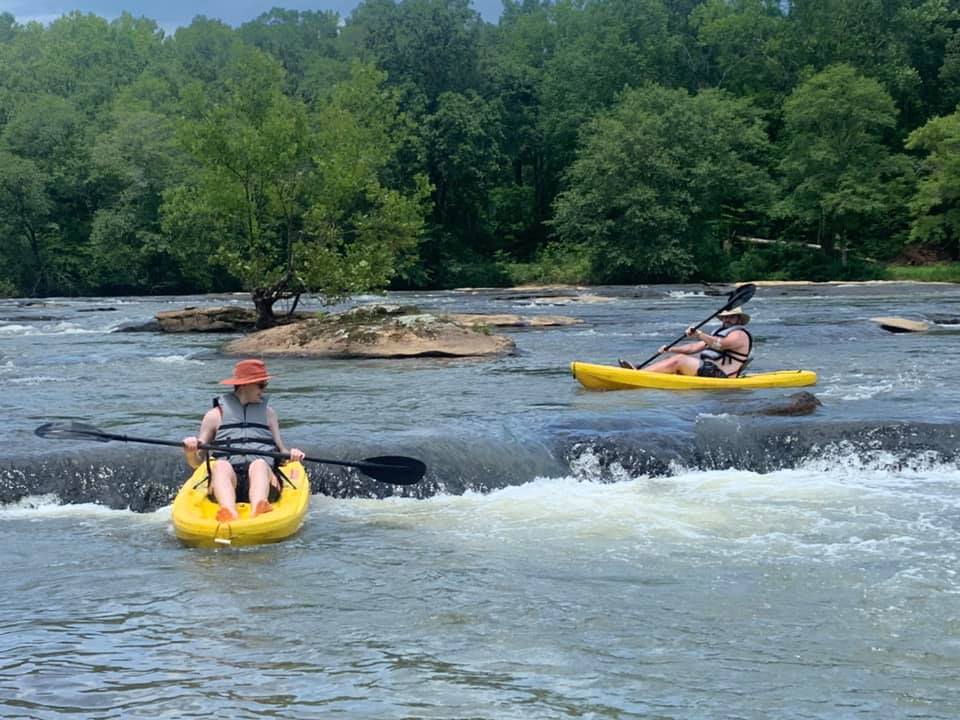When you spend time in the Lake Hartwell area, you are sure to experience many forms of wildlife, but there’s at least one you may want to avoid: the Georgia copperhead snake.
These snakes account for the most venomous bites in the Southeast U.S. each year. Copperhead snakes in Georgia and South Carolina are accustomed to a wide variety of habitats, from forests to rocky areas and, yes, lakes too. This guide will help you know how to identify a copperhead, plus what to do if you are bitten by one.

Southern copperheads prefer wooded areas and like to lay camouflaged among the debris under trees.
How to ID a Copperhead From Look Alikes
The Georgia copperhead snake is a light to deep tan and brown color. Their “signature feature” is the striking copper color of their head, but it’s important to note that not all of them have this.
However, they DO all have bands that look like Hershey Kisses when viewed from the side. From the top, the bands look like hourglasses. Compared to other venomous snakes in the area, the copperhead in South Carolina and Georgia:
-
will often have bright, copper-colored scales on its head
-
is not red at all, unlike the coral snake
-
has no rattle, as the three types of rattlesnakes do (pygmy, timber, and eastern diamondback)
-
will try to escape humans, unlike the cottonmouth snake
-
has a bright yellow tail as a juvenile snake
-
has a triangle-shaped head similar to the rattlesnakes and cottonmouth, a sign they are pit vipers
People on Lake Hartwell who are not from the area or unfamiliar with snakes may mistake the copperhead with the northern water snake, which can have similar coloring and patterns. The northern water snake, however, is not venomous and it does not have a triangle head.
Similarly, other snakes in the area such as the corn snake and brown water snake may be confused with the copperhead. Look for the triangle head and copper scales to truly know you’re encountering a Georgia copperhead.
Before a copperhead snake bites, it will shake its tail. This is similar to a rattlesnake, but they do not have rattles. Instead, it will emit a strong musk. So if you notice any odor, move away.
Tip: Try this no-stink snake repellent to keep copperheads out of your yard.
Copperhead Snake Habitat
The copperhead is found throughout all of South Carolina and most of Georgia. It prefers to live in forests with lots of leaf litter. However, it will live in rocky areas and in marshes where food is plentiful year-round. They are especially fond of areas where two different types of ecologies exist. This can include rocky forests and mountains, bushy areas near streams, and almost any habitat that has cover and sunlight. Usually, trees need to be present for Georgia copperheads to like the area, but it is not guaranteed. They are commonly found in suburban areas, especially those with lots of tree cover. Seasonally, their habitat won’t change. However, the time of day they are active changes with the seasons. During the Spring and Fall, they are very active during the day. In contrast, during the summer they are active mostly at night, especially when it’s humid. They will most likely be found on warm rocks and pavement when the sun is out. They use camouflage for protection, so be careful when treading through leafy areas. For this reason, it is strongly suggested to use a walking stick when hiking through these areas on foot. You may be able to see it move before you come too close to it.

Note the Hershey Kiss shaped markings on this copperhead.
If you Encounter A Copperhead Snake
Before you get too nervous, it’s important to know that copperhead snakes in Georgia are not fond of humans. They view us as a bigger predator, so the Georgia copperhead will often simply turn and slither away quickly. Another behavior they show is playing dead and camouflaging by lying completely still when scared. If you happen to see one, make sure to give it plenty of room, just as you should with any snake.
Back away slowly if you are remotely near striking distance where the snake can reach you.
If the snake feels trapped or backed into a corner in the wild, this is when the Georgia copperhead will most likely stand its ground. It may strike out as you pass by if you get too close.
If its fangs penetrate your skin, it is usually not too deep, and it may inject a small amount of venom. Seek medical attention immediately even if you do not think venom is present.
Another important thing to know is copperheads in South Carolina are very aggressive if you attempt to handle them. Do NOT attempt this. Even if you are sure the snake is non-venomous, it can still deliver a painful bite. If you encounter a snake of any kind, know that it is illegal to kill a non-venomous snake in Georgia.

Copperheads are more active at night during the summer months.
What To Do If Bitten By Copperhead Snake
A copperhead’s bite is not as potent as some other snakes. However, if bitten, seek medical assistance immediately after following the next steps, even if severe damage doesn’t appear immediately. This applies even more so to children and pets.
Do:
-
Remain calm
-
Identify what kind of snake bit you by making mental notes or snapping a photo quickly
-
Remove any tight clothing and jewelry to prevent constriction due to swelling of the bitten area
-
Wash the area with soap and water, then apply a clean bandage
Do not:
-
Apply a tourniquet or restrictive clothing that would stop blood flowing to the area
-
Induce further damage to the area by cutting or applying heat or cold
-
Drink liquids like alcohol or coffee that will increase heart rate or thin blood
-
Take any medicine or drugs until medical attention is sought
Make sure you carry a lightweight first aid kit with you at all time when you’re exploring the outdoors. This will ensure you have the basic supplies to take care of injuries while you get to a medical professional.
The good news-bad news situation with the Georgia copperhead.
-
On the negative side, a copperhead is one of the most likely reptiles to bite a human.
-
On the plus side, a copperhead’s venom is one of the least potent in the United States.
This story about a dog saving its owner from a juvenile copperhead shows how mild the bite can be. A teenager was bitten by a copperhead in Georgia and suffered swelling and pain but was treated without needing antivenom. However, we reiterate that every bite needs medical attention. Sadly, one Georgian woman died after being bitten by a rattlesnake in her garden.
Your best course of action is to keep alert and observe your surroundings. If you do see a snake, respect its space and you’ll both be happy.







